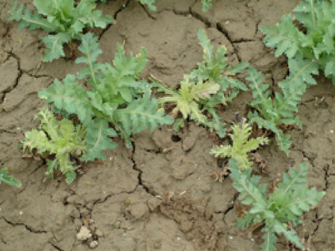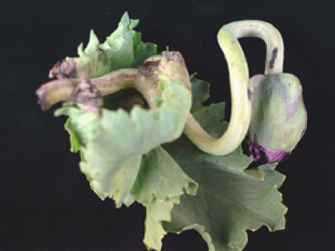Downy mildew on poppy
Peronospora arborescens
Damage symptoms
The first symptoms of downy mildew are yellowish brightenings on the tops of the leaves, sometimes the entire plant is discolored yellow. These spots are between 0.5 and 4 cm in size. The infected tissues are often curled, bulging or thickened. Infected young plants are conspicuous in stands by their pale or already yellowish-white leaves. They are retarded in growth and may also die completely. Infested flower stalks turn inwards, the buds or sepals can also be infested and the plants subsequently die. If the capsules are infested, the seeds are also infected. The typical, initially whitish, later grayish-purple sporangia can be seen on all infested plant parts, especially in humid weather.




Propagation and transmission
Spread occurs through infected seeds. Furthermore, the pathogen forms sporangia carriers with sporangia, which release mobile spores (zoospores). The sporangia usually grow on the undersides of the leaves from the stomata or other openings in the plant. The sporangia are spread by wind or rain. The zoospores require dripping water to travel and germinate. After germination, they penetrate directly into the plant tissue.
To survive, the pathogen forms robust spores (oospores). They are spherical and dark brown in color, but not visible to the naked eye. Oospores can survive in the soil for several months.
Prevention and control
- Adherence to a crop rotation of at least three years
- Use of healthy seeds
- In case of heavy infestation, use of approved plant protection products (see list of plant protection products approved in Austria)
Last updated: 23.11.2021
automatically translated